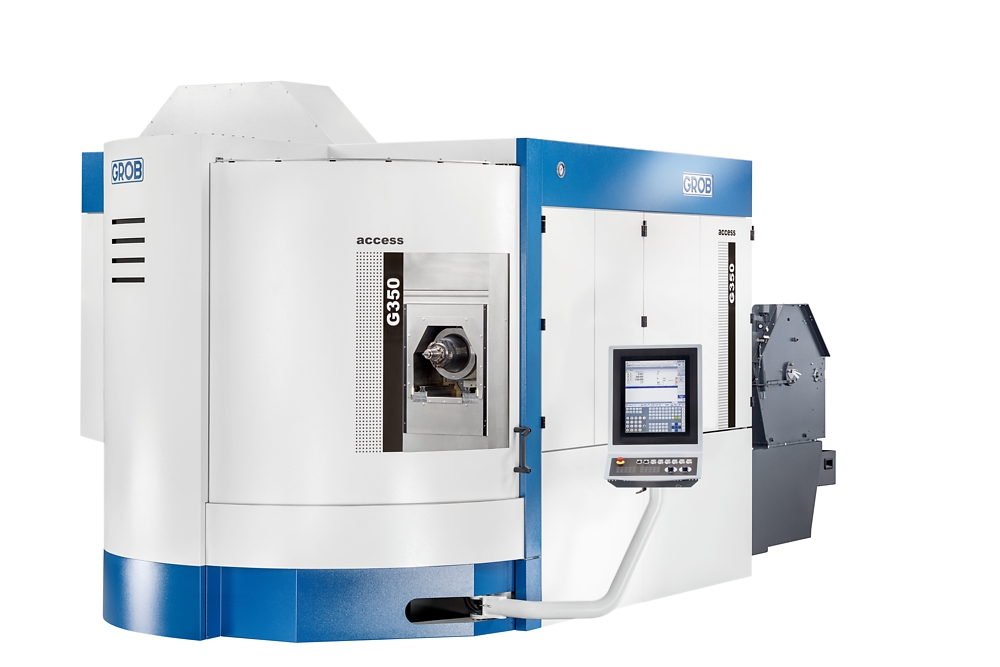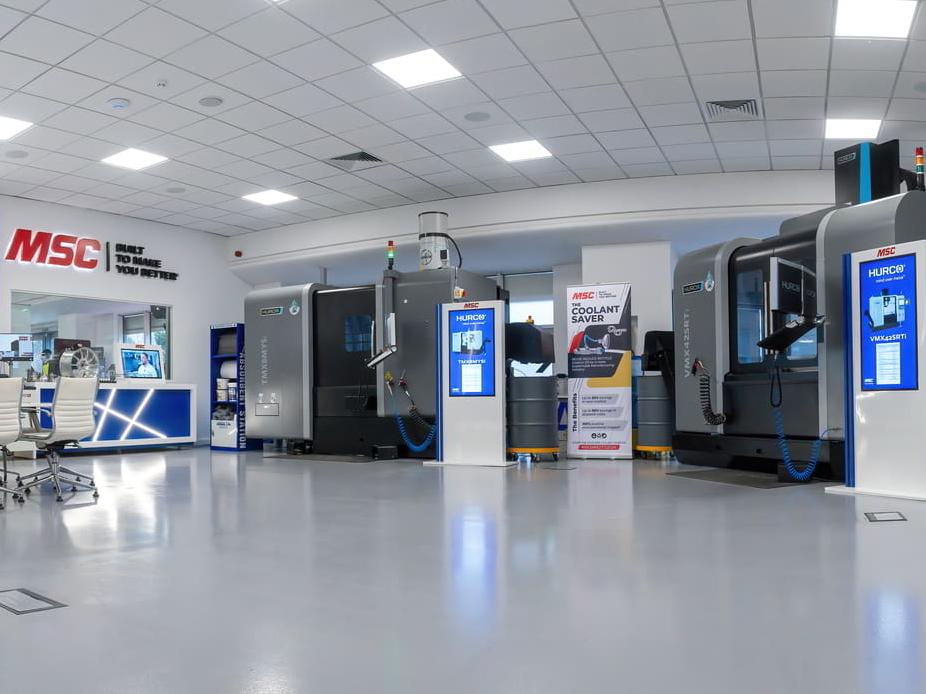New entry-level 5-axis machine pushes productivity to the max

Grob Systems’ universal machine sales supervisor, proposals & applications, Derek Schroeder explains how the company’s latest entry-level 5-axis machining centre offers many of the features of high end machines without the hefty price tag.
Grob Systems’ universal machine sales supervisor, proposals & applications, Derek Schroeder explains how the company’s latest entry-level 5-axis machining centre offers many of the features of high end machines without the hefty price tag.
Industry is moving inexorably towards automation, in which unmanned machines can increase productivity while reducing waste.
Prior to 2015, around one in ten 5-axis universal milling machining centres sold by Grob Systems Inc. featured automation, but now that figure has risen to nearly half. Subject to pressures to reduce scrap and increase throughput, smaller job shops often lack the budget for higher end 5-axis machines. Now, new 5-axis machine technology is available to help them evolve in this Industry 4.0 era of machine monitoring and connected machines.
SMEs are looking for flexible solutions that can be used for every challenge, customer, and market – from medical, aerospace, and automotive, to mould and die and energy. One example of entry-level 5-axis machine technology being developed for these smaller job shops is Grob Systems’ new Access Series 5-axis machining centre, which offers many of the features of high-end machines but at a price that results in a short payback time.
With the new technology, manufacturers can be assured of getting as much spindle utilisation as possible. They can also keep machines running unattended. For example, if they are changing a part at first shift, they can keep the machine running without an operator for several shifts, resulting in less cost to the customer. In addition to running automated for production runs, the flexible machine can also be operated in manual mode for part setups, prototyping, or small batch runs.

Three linear and two rotary axes permit five-sided machining, as well as 5-axis simultaneous interpolation. The axis arrangement provides a generously large swivel range, larger than most other options for positive angle of solutions. For negative angles, two options give good access to the part without having to make different fixtures and compensate in other ways. This means the largest possible part in the work area can be machined with maximum tool length.
Small in size, big on features
The compact machine concept provides SMEs with a small footprint, but with features often found only in larger machines. One key aspect is a rigid spindle axis, designed so the machine is most rigid at the part, thanks to an optimally positioned bearing close to the operating point.
This rigidity at the part means the machine can remove material faster, with less vibration and using a more constant process. The rigidity also reduces tooling costs, enabling operators to be more productive, and increasing the profit from the machine.
Another design feature is a long Z-travel path, which enables tool change to happen outside of the work area. Many other designs require tool change to occur in the work area, which provides a smaller available area for the part. The new machines provide 1,020mm of Z-axis travel – the longest in this machine class – while other competitive machines range from 400 to 650mm.
Active cooling of heat-absorbing components and assemblies makes for efficient machine cooling, and an innovative overhead machining function offers excellent chip fall and reduced thermal load in the component. Operators can choose between Siemens and Heidenhain machine control systems.
The reference axis’ linear guidance system can be equipped with a temperature-controlled cooling function, and a wide-opening work area door ensures safe and ergonomic access. The machining process is viewed through a laminated safety glass.
Most flexible machine shops need tool storage capacity, and the new technology offers a variety of options for storing tools inside the machine. The single disk option enables users to hold approximately 50 tools around the outside of the disk; the double disk option increases tool capacity without making the machine bigger.
The machine uses Grob’s Swivel Axis Calibration (GSC) technology to find and compensate for volumetric errors. Unlike other technology that can compensate for four positions/compensation points using the controls, GSC is freely definable and can compensate for 40-50 positions/compensation points.
The entry-level 5-axis technology can run on the same platform as other machines, which can all be connected to the same automation. Since operation across the range of machines is identical, operators and maintenance staff already have familiarity, making transition easier.
Linear pallet storage system with low investment
The technology is available with a linear pallet storage system (PSS-L) that can be used for a wide variety of part types. Flexibly configurable according to user requirements, the PSS-L provides a complete solution from a single source in a standardised design and an interface optimally matched to the machine.

The PSS-L is a modular system for individual machines or for interlinking the same machining systems. It can be used with different machine types, numbers of machines, and numbers of set-up stations. Users can customise the mechanical layout to make it fit plant or part requirements and can customise the software.
For example, if the user has a database for tracking fixtures or tooling offsets, the machines can communicate with the database and control that data. Up to five machine tools can be connected to pallet storage racking with a maximum of 87 pallet positions. The PSS-L can also operate as an independent machine.
The PSS-L provides a longer and unmanned production period and allows optimum access to the machine’s work area during automation, for example for manual loading or set-up work.
Customers can connect a mix of machine types on one line, keeping all operations in the same system, performing them all in the same cell. For example, they may perform part turning operations first, then move to a milling-only second operation. If they want to segregate operations between machines they can do so. The key is that they do not have to remove the part from a lathe for turning and then move the part over to the linear system.
The storage solution features a linear travelling pallet changer system with a pallet gripper to transport the materials between setting stations, workpiece deposits and machines. It does not use any cable track and the pallets are staged close to the machine to prevent long exchange times. An easily accessible set-up station features crane loading capability.
The system also comes with production control software, so users have a simple, intuitive organisation of pallets and parts with associated process steps. Customers can have autonomous part and pallet control while considering resources, along with monitoring and verification of tool resources for all scheduled orders.
Proven in the field
The new technology was launched in September 2019 and is already being used in Europe and Asia. One example is an aerospace repair centre in Poland, which did not have the budget for a larger machine and is using the new unit for engine repairs and overhaul.
A UK aerospace manufacturer purchased a unit because it liked the idea of getting all its machines from one supplier. The company had several large Grob machines and will use the smaller units to automate all the existing machines, which are used for manufacturing aerostructure parts.
A mechanical engineering firm in Germany looking for a lower cost solution opted for the Access unit to manufacture parts for its own automation products. A final example is a die and mould shop in Germany, which purchased a unit as a lower cost alternative to the higher cost machines it already had on the production floor. The unit is being used for manufacturing of injection moulds.
Automation often involves many issues that may be difficult to navigate. Many are looking for a single supplier that can furnish all required equipment, rather than one supplier for automation and one machine tool builder for the machine. The new machining centre and linear pallet storage system fits the bill, with one supplier supporting an entire system that is ideal for increasing unmanned operation and reducing scrap and waste.
Grob www.grobgroup.com















